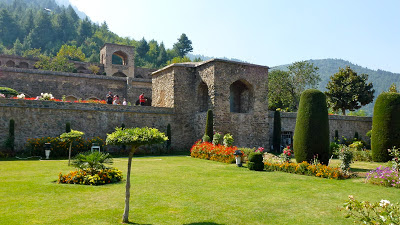The Shalimar was a royal garden, and as it is fortunately kept up by His
Highness the Maharaja of Kashmir, it still shows the charming old plan
of a Mughal Imperial summer residence. The present enclosure is five
hundred and ninety yards long by about two hundred and sixty-seven yards
broad, divided, as was usual in royal pleasure-grounds, into three
separate parts: the outer garden, the central or Emperors garden, and
last and most beautiful of the three, the garden for the special use of
the Empress and her ladies.
The outer or public garden, starting with the grand canal leading from
the lake, terminates at the first large pavilion, the Diwan-i-Am. The
small black marble throne still stands over the waterfall in the centre
of the canal which flows through the building into the tank below. From
time to time this garden was thrown open to the people so that they
might see the Emperor enthroned in his Hall of Public Audience.

Manasbal Lake is located about 30 km north of Srinagar, the summer
capital of Jammu and Kashmir State. It has predominantly rural
surroundings with three villages, Kondabal, Jarokbal and Gratbal
overlooking the lake. Manasbal is considered as the 'supreme gem of all
Kashmir lakes' with lotus (Nelumbo nucifera) nowhere more abundant or
beautiful than on the margins of this lake during July and August. It
is the deepest lake of Kashmir valley and perhaps the only one that
develops stable summer stratification. Manasbal is classified as warm
monomictic lake and circulates once in a year for a short time. The
other lakes in the region either have weak stratification or are
polymictic. Close to the northern shore are the ruins of a fort which
was built in 17th century by a Moghul king to cater the needs of
caravans that used to travel from Panjab to Srinagar. On the south,
overlooking the lake is a hillock-Ahtung which is used for limestone
extraction. The eastern part is mainly mountainous and towards the
north is an elevated plateau known as 'Karewa' consisting of lacustrine,
fluviatile and loessic deposits. 

Pari Mahal was built in the mid-seventeenth century on the ruins of a Buddhist monastery by Prince Dara Shikoh, the eldest son of Shah Jahan. Prince Dara, a follower of the Qadiri order of Sufi Islam, had a great interest in mysticism, and he built the garden for his Sufi tutor, Mullah Shah Badakhshi. It was used as an observatory for the teaching of astrology and astronomy. Prince Dara was assassinated in 1659 by his younger brother, Aurangazeb, who went on to take control of the empire.
Asia's largest tulip garden in Kashmir was started as an ornamental display in 2008 with an aim of advancing the tourist season but floriculturists here have seized a business opportunity by introducing the flowers on a commercial scale.












No comments:
Post a Comment